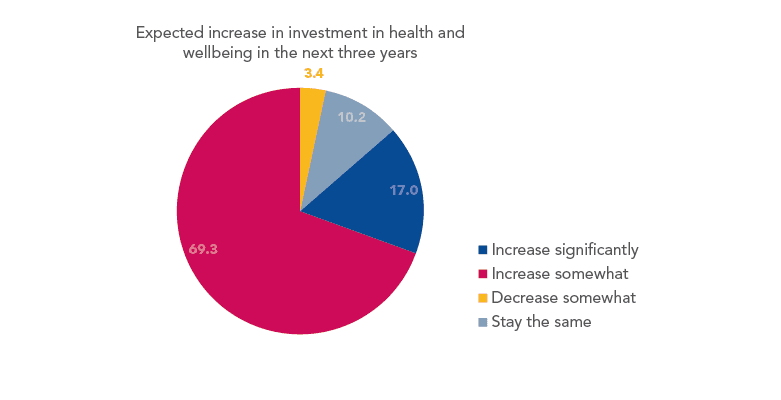There are a number of factors influencing how universities are being built. In the following article we focus on the importance of health and wellbeing and how it could impact the campus of the future.
Health & Wellbeing
Conversations on campus sustainability have evolved to address the health and wellbeing of students and staff. There is a growing body of evidence showing a clear link between the physical characteristics of the built environment and the health and wellbeing of its occupants. As the evidence base has grown, cultivating a healthy environment that promotes student wellbeing has gone from being a minor consideration to the “new normal”.
Research from the Urban Land Institute (ULI), the research and education organisation focused on the built environment, found that rising levels of interest in wellbeing in the UK will translate into significant investment over the next three years in the real estate industry.
The report - which is based on a survey of over 100 investors, developers, fund managers, consultants, valuers and analysts – found that 86% of respondents expect to increase their investment in wellbeing in the next three years, with 17% anticipating this increase to be ‘significant’.1

Health and wellbeing are clearly becoming more central to investment and development strategies within the built environment.
According to the survey, current investment in health and wellbeing is impacting the physical aspects (or design) of the asset cycle the most, as these aspects are generally seen as the easiest place to incorporate wellbeing ideas.
UK universities have started pursuing the WELL Building Institute’s WELL certification – a performance-based rating system for measuring, certifying and monitoring features that impact human health and wellness in the built environment. The ‘WELL v2’ Building Standard uses 10 concepts (Air, Water, Nourishment, Light, Movement, Thermal Comfort, Sound, Materials, Mind and Community) to assess whether a building supports and advances human health and wellbeing.
The University of Winchester was one of the first university projects in the UK to pursue the WELL certification with its new £50m landmark West Downs Building.
Scheduled to open in early 2020 and aiming to achieve Gold WELL Certification, the building will feature:
- Contemplation space for practising mindfulness
- Healthy food options
- Access to nature through the courtyard garden
- Landscaped areas for encouraging outdoor use
- Reduced harmful buildings emissions, including air and water testing
- Workstations with adjustable height sit-stand desks
Research indicates that incoming students prioritise a healthy lifestyle and seek a campus which supports their wellness. Choice of a healthy living environment is becoming more of a common conversation during the application process.
Whilst there isn’t yet a substantial amount of data supporting the investment case for incorporating wellbeing changes like there is for sustainable buildings, anecdotal evidence suggests health and wellbeing initiatives improve performance in the long run. For example, in commercial offices the World Green Building Council says:
“Productivity improvements of 8%-11% are not uncommon as a result of better air quality”
Evidence also suggests incorporating WELL standards results in reduced absenteeism (30% improvement), lower staff turnover (with one study citing a possible 27% improvement), and improved mental health (the single largest cause of long-term absence from work).2
Furthermore, research by Harvard University examining the link between cognitive function and the internal working environment found that on average cognitive scores were 61% higher in green building conditions and 101% higher in ‘enhanced’ green building conditions. CO2, volatile organic compound levels (VOCs) and ventilation rate all had significant, independent impacts on cognitive function. Adopting WELL standards could therefore have far reaching implications for student learning.3
G&T has found that the uplift for achieving WELL for shell and core is in the range of £1.00-1.50 per square foot on larger projects that have a high standard base build. The fit-out premium is a little higher, with our sources informing us of a 2-4% range.4
Building Magazine recently estimated that an even higher fit-out cost premium of between £3-8/ft² NIA (3-8%) in order to achieve WELL Gold when compared to a standard CAT B fit-out rate of 100/ft². Specification upgrades drive this cost uplift in their model.
Applying WELL standards to University campus buildings also have measurable qualitative impacts. Pre and post-occupancy evaluation surveys have shown the perceived sense of wellbeing, community and enjoyment of the environment all rose after becoming WELL certified.5
Finally, by focusing on creating healthier environments, developers are helping Universities stave off the risk of obsolescence by differentiating themselves and making a statement about their campus and community.
Read the other articles in our series: The Campus of the Future





